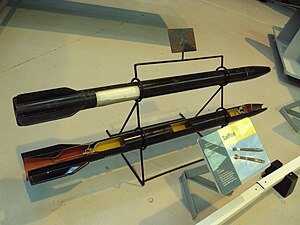Taifun (rocket)
This article includes a list of general references, but it lacks sufficient corresponding inline citations. (April 2011) |
- This article is about the German World War II anti-aircraft unguided rocket system. For the similarly named Soviet anti-tank missile, see Taifun. For the 1933 German film, see Typhoon. For the Messerschmitt pre-war monoplane with the name, see Bf 108. For the weather event, see Typhoon.

Taifun (German for "typhoon") was a German World War II anti-aircraft unguided rocket system. Waves of Taifuns were to be launched en masse into US B-17 Flying Fortress formations hoping for a direct hit. Although never deployed operationally, the system was copied in the US as the Loki, and the USSR as R-103.[citation needed]
The Taifun project originally dates to 25 September 1942, when Hermann Göring authorized the start of a number of anti-aircraft projects after a long hiatus when all such advanced development had been frozen by Hitler. Along with the Taifun, the Enzian, Rheintochter, Schmetterling, and Wasserfall were also given full funding. The design was originally started by Scheufeln, an officer at Peenemünde, who wanted to introduce an extremely simple system in case the more complex projects did not "work out".
The Taifun proposal was developed by a small team at Peenemünde along with the Electromechanische Werke in Karlshagen. Their design was 1.93 m (6 ft 4 in) long and 10 cm (3.9 in) in diameter, with four small stabilizing fins at the base. The rocket was driven by a liquid fuelled engine using Tonka 250, a hypergolic mixture comprising 57 percent of raw xylidine and 43 of triethylamine fed into the combustion chamber under pressure.[1][2] The pressure was provided by small cordite charges fired into the fuel tanks, in the process bursting a pair of thin diaphragms to allow the fuel and oxidizer to flow into the combustion chamber, and launched the rocket. The burn was 2.5 seconds, by which time the rocket had achieved a speed of 2,237 mph (3,600 km/h; 1,944 kn). Nominal range was to have been about 15 km (9.3 mi; 8.1 nmi), with a maximum altitude of 12 km (39,000 ft).[3] The rockets were fired in salvos of up to 30 from a launcher mounted on an adapted 88 mm gun mounting.
The original plans called for 2 million to have been produced by January 1945, but the engine experienced lengthy delays and none was ever deployed operationally. The only such system to see operational use was British, who deployed both the Unrotated Projectile and 2 inch RP during the war.
References
